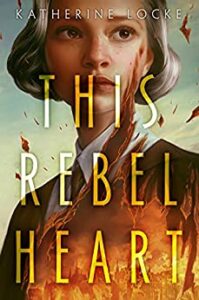This Rebel Heart
Katherine Locke
Knopf Books for Young Readers
Published April 5, 2022
Amazon | Bookshop | Goodreads
About This Rebel Heart
A tale set amid the 1956 Hungarian revolution in post-WWII Communist Budapest.
In the middle of Budapest, there is a river. Csilla knows the river is magic. During WWII, the river kept her family safe when they needed it most–safe from the Holocaust. But that was before the Communists seized power. Before her parents were murdered by the Soviet police. Before Csilla knew things about her father’s legacy that she wishes she could forget.
Now Csilla keeps her head down, planning her escape from this country that has never loved her the way she loves it. But her carefully laid plans fall to pieces when her parents are unexpectedly, publicly exonerated. As the protests in other countries spur talk of a larger revolution in Hungary, Csilla must decide if she believes in the promise and magic of her deeply flawed country enough to risk her life to help save it, or if she should let it burn to the ground.
My Review of This Rebel Heart
The author’s note at the beginning of the book warns that Hungary’s revolution does not end in victory, so I felt like I read this entire book holding my breath, waiting for that shoe to drop. Which wasn’t a negative for me– just added a lot of intensity.
Csilla was my favorite character, but I loved the other characters, too. I loved the way that magic is woven into the story through Csilla’s relationship with the river. The way that color (or a lack of it) is used in the story, too, is really powerful and cool.
The way the story is written completely captivated me. I felt like I couldn’t stop reading, and like so many of the scenes were just aching– achingly beautiful or haunting or tragic. I feel like it struck something in me really deeply, a kind of connection with a book that I haven’t felt since reading THE BOOK THIEF years ago, where it made me want to call people and read them pages of the story.
I’m trying not to buy any new books right now because SHELF SPACE, but I really want a hard copy of this one. THIS REBEL HEART is the first book I’ve read by Katherine Locke, but obviously I need to read all their other books immediately. I absolutely loved it.
I think readers who enjoyed THE GIRL IN THE BLUE COAT by Monica Hesse or books by Ruta Sepetys would love THIS REBEL HEART.
Content Notes for This Rebel Heart
Recommended for Ages 14 up.
Representation
Csilla is Jewish. Other characters are gay or bisexual.
Profanity/Crude Language Content
Extreme profanity used very infrequently.
Romance/Sexual Content
Reference to a kiss between two men. Kissing between two boys. Kissing between a boy and girl. Two boys and a girl are in a romantic relationship together.
Spiritual Content
References to Jewish holidays and practices. One character is an angel of death.
Violent Content
References to genocide, some brief graphic references to death in gas chambers. References to torture and suicide. Brief description as a mob beats a young man to death. Soldiers shoot into a crowd of protestors, killing someone. Some battle violence and other situations of peril.
Drug Content
Characters drink socially at a community dance.
Note: This post contains affiliate links, which do not cost you anything to use, but which help support this blog. I received a free copy of THIS REBEL HEART in exchange for my honest review.
